
The Scrophulariaceae are a family of flowering plants, commonly known as the figwort family. The plants are annual and perennial herbs, as well as shrubs. Flowers have bilateral (zygomorphic) or rarely radial (actinomorphic) symmetry. The Scrophulariaceae have a cosmopolitan distribution, with the majority found in temperate areas, including tropical mountains. The family name is based on the name of the included genus Scrophularia L.

Lathraea (toothwort) is a small genus of five to seven species of flowering plants, native to temperate Europe and Asia. They are parasitic plants on the roots of other plants, and are completely lacking chlorophyll. They are classified in the family Orobanchaceae.
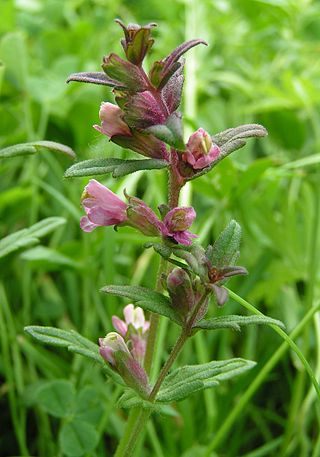
Odontites is a genus of flowering plants in the family Orobanchaceae.

Paulowniaceae are a family of flowering plants within the Lamiales. They are a monophyletic and monogeneric family of trees with currently 7 confirmed species. They were formerly placed within Scrophulariaceae sensu lato, or as a segregate of the Bignoniaceae.

Orobanchaceae, the broomrapes, is a family of mostly parasitic plants of the order Lamiales, with about 90 genera and more than 2000 species. Many of these genera were formerly included in the family Scrophulariaceae sensu lato. With its new circumscription, Orobanchaceae forms a distinct, monophyletic family. From a phylogenetic perspective, it is defined as the largest crown clade containing Orobanche major and relatives, but neither Paulownia tomentosa nor Phryma leptostachya nor Mazus japonicus.

Euphrasia, or eyebright, is a genus of about 450 species of herbaceous flowering plants in the family Orobanchaceae, with a cosmopolitan distribution. They are hemiparasitic on grasses and other plants. The common name refers to the plant's use in treating eye infections.

Melampyrum is a genus of about 20 species of herbaceous flowering plants in the family Orobanchaceae known commonly as cow wheat. They are native to temperate regions of the Northern Hemisphere. They are hemiparasites on other plants, obtaining water and nutrients from host plants, though they are able to survive on their own without parasitising other plants.
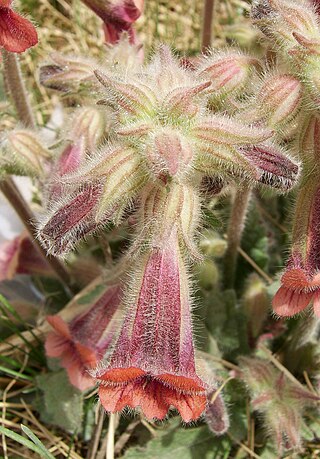
Rehmannia is a genus of seven species of flowering plants in the order Lamiales and family Orobanchaceae, endemic to China. It has been placed as the only member of the monotypic tribe Rehmannieae, but molecular phylogenetic studies suggest that it forms a clade with Triaenophora. Contrary to the immense majority of the taxa of Orobanchaceae, Rehmannia is not parasitic.

Rhinanthus is a genus of annual hemiparasitic herbaceous plants in the family Orobanchaceae, formerly classified in the family Scrophulariaceae. Its species are commonly known as rattles. The genus consists of about 30 to 40 species found in Europe, northern Asia, and North America, with the greatest species diversity in Europe.
Neobartsia alba, formerly Bartsia alba, is a species of flowering plants in the family Orobanchaceae. It is endemic to Ecuador.

Bartsia is a genus of flowering plants in the family Orobanchaceae.
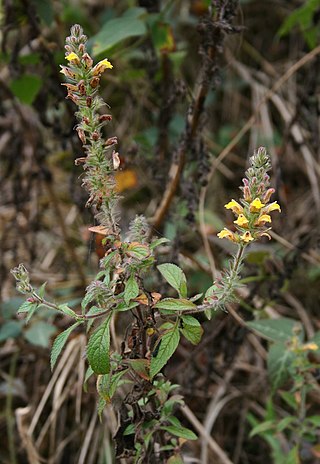
Lindenbergia is a genus of herbaceous plants in the order Lamiales and in the broomrape family Orobanchaceae. It is one of the few genera of the family which are not parasitic. It contains about 15 species found from northeast Africa across Asia to the Philippines, and is most abundant in India.

Bellardia trixago is a species of flowering plant in the family Orobanchaceae. The only member of the monotypic genus Bellardia, it is known as trixago bartsia or Mediterranean lineseed. This plant is native to the Mediterranean Basin, but it is known in other places with similar climates, such as California and parts of Chile, where it is an introduced species and noxious weed.
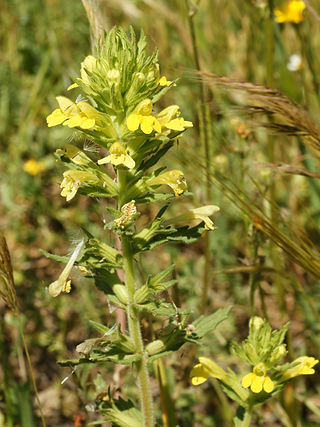
Parentucellia is a small genus of flowering plants in the family Orobanchaceae containing about four species. They are known generally as glandweeds. The genus was named for Pope Nicholas V, whose surname was Parentucelli.

Rhinantheae is a tribe with less than 20 genera of herbaceous plants in the family Orobanchaceae.

Rhynchocorys is a small genus of flowering plants belonging to the family Orobanchaceae, formerly classified in the family Scrophulariaceae. It is native to Europe, Morocco and Algeria.
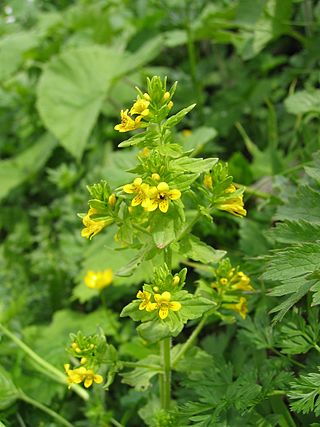
Tozzia is a monotypic genus of flowering plants within the broomrape family Orobanchaceae. It contains a unique species, Tozzia alpina.

Hedbergia decurva, formerly Bartsia decurva, is a species of flowering plants in the family Orobanchaceae.
Hedbergia longiflora, formerly Bartsia longiflora, is a species of flowering plants in the family Orobanchaceae.
Bartsiella is a monotypic genus of flowering plants, initially classified in Scrophulariaceae, and now within the broomrape family Orobanchaceae. It contains a unique species, Bartsiella rameauana.
















